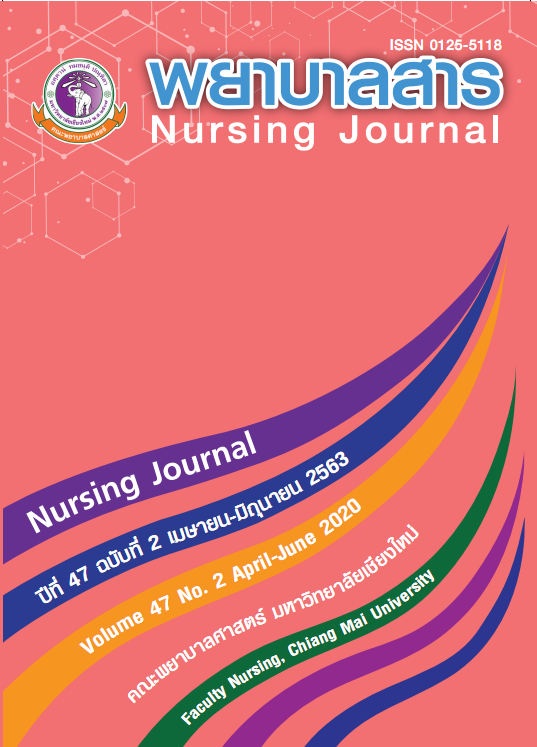Situational Analysis of Risk Management in Female Medical Ward at Hospital in the Northern Region of Thailand
Keywords:
Situational analysis, Risk management, Patient safetyAbstract
Risk management is important to ensure the quality of health services, especially the patient safety. The objective of this descriptive study was to analyze situations of risk management and describe solutions for risk management problems in the Female Medical Ward at Hospital in the northern region of Thailand, by studying the documents and information of risk management, interviewing six risk management committee members, and conducting a group meeting of 26 nursing staff working in the Female Medical Ward. Research instruments consisted of semi structured-questions developed from the conceptual framework of the Donabedian model for quality assessment (2003), which includes structure aspect, process aspect, and outcome aspect. Data was analyzed using content analysis.
The results were as follows:
- Regarding the structure aspect in the Female Medical Ward, there were risk management policies, which were guided by patient safety. However, they were not successfully implemented, due to the following reasons, there are budget problems, personnel, workplace, difficulty and inconvenience in using quality tools, and lack of knowledge on how to use quality tools. Suggestions included having a variety of clearly laid out channels of communication for risk management policy, preparing for budget, integrating risk management to routine work, assigning proper tasks and personnel according to workloads, and educating nursing personnel on how to use quality tools.
- Regarding the process aspect, it was found that there are problems at every step of risk management, including risk search, risk assessment, risk management and evaluation. Suggestions included strategies to encourage and improve assessing and reporting risk, having risk management handbook or guidelines, having supervision and communication on risk guidelines or managing risk, continuous monitoring, evaluating, and improving risk management, and consistently coordinating a multidisciplinary team.
- Regarding the outcome aspect, it was found that the planned outcomes were not achievable. Suggestions included encouraging staff to report incidents, monitoring risk reporting of staff for every shift, urging data recording, promoting a positive attitude toward reporting, and monitoring risk management indicators every month.
The results patient safety this study can be used by the hospital and nurse administrators to improve the risk management system in Female Medical Ward.
References
Aranaz-Andres, J. M., Aibar-Remon, C., Vitaller-Murillo, J., Ruiz-Lopez, P., Limon-Ramirez, R., & Terol-Garcia, E. (2007). Incidence of adverse event related to health care in Spain: Results of the Spanish National Study of Adverse Events. Journal of Epidem & Community Health, 62 (12), 1022-1029. doi:10.1136/jech.2007.065227
Chanpanyasakul, O. (2010). The situation analysis of risk management in the pediatric ward 3,Maharaj Nakorn Chiang Mai hospital (Independent Study, Chiangmai University). (In Thai)
Donabedian, A. (2003). An introduction to quality assurance in healthcare. Oxford: Oxford University Press.
Health Administration Division. (2010). Guidelines for the management of patient safety in hospitals (1st ed.). Bangkok: Chongchian marketing.
Nantsupawat, R., Wichaikhum, O., & Nantsupawat, A. (2014). The relationship between Nurses’Extended work hours and patient, nurse, and organizational outcomes in general hospital. Nursing Journal, 41 (4), 58-69. (In Thai)
Nilprayoon, P. (2012). Situation analysis of risk management in Male Medical Ward 2, a t Nakornping Hospital, Chiang Mai Province (Independent Study, Chiangmai University). (In Thai)
O’Byrne, P. (2008). The dissection of risk: A conceptual analys is. Nursing Inquiry, 15 (1), 30-39.
PricewaterhouseCoopers. (2004). The risk management. Bangkok: Pricewaterhouse Coopers international. (In Thai)
Saenprasan, P. (2006). Nursing management for security. Bangkok: Sukhumvit printing. (In Thai)
Sawangdee, K. (2004). The quality of hospital care: Guidelines for internal quality a ssessment.Nonhaburi: Strategy and Planning Division, Ministry of Public H ealth. (In Thai)
Srisatidnarakul, B. (2007). Leadership and strategic management in nursing organization for the 21st century. Bangkok: Chulalongkorn University printing house. (In Thai)
Supeesudh, P. (2550). Risk management in healthcare organizations, community hospital Servias (Master’s thesis, Burapha University). (In Thai)
Suphachutikul, A. (2001). Course to quality hospitals: Manual learning to practice (2nd ed.). Bangkok: The Healthcare Accreditation Institute. (In Thai)
The Healthcare Accreditation Institute (Public Organization).(2015). Hospital and health carestandards Sixtieth Anniversary Cerebrations of His Majesty’s A ccession to the Throne Edition. Nonthaburi: The Healthcare Accreditation Institute. (In Thai)
Unahalekhaka, A. (2005). Surveillance and outbreak investigation of nosocomial infection s inhospitals. Chiangmai: Mingmeang. (In Thai)
Wilson, C. R. M. (1992). QA/CQI: Strategies in health care quality. Toronto: W.B. Saunders.
Downloads
Published
How to Cite
Issue
Section
License
บทความที่ได้รับการตีพิมพ์เป็นลิขสิทธิ์ของวารสารพยาบาลสาร
ข้อความที่ปรากฏในบทความแต่ละเรื่องในวารสารวิชาการเล่มนี้เป็นความคิดเห็นส่วนตัวของผู้เขียนแต่ละท่านไม่เกี่ยวข้องกับมหาวิทยาลัยเชียงใหม่ และคณาจารย์ท่านอื่นๆในมหาวิทยาลัยฯ แต่อย่างใด ความรับผิดชอบองค์ประกอบทั้งหมดของบทความแต่ละเรื่องเป็นของผู้เขียนแต่ละท่าน หากมีความผิดพลาดใด ๆ ผู้เขียนแต่ละท่านจะรับผิดชอบบทความของตนเองแต่ผู้เดียว






